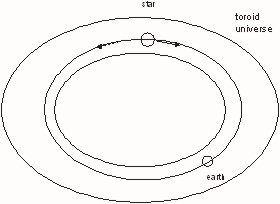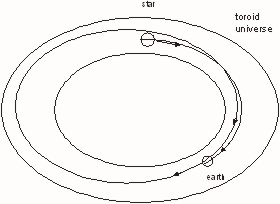Impact of a Toroid Shaped Universe
First consider a star across the toroid from our sun, it would mean that the light from that stars will reach the earth from two different directions, almost but not quite 180 spherical degrees from each other.
Second it would mean that we would see the light from the same star once and then a second time or third as the light traveled completely around our universe (toroid) two or three times. Each time the star would appear in a different location in our heavens because of the movement of the star relative to the earth and the center of the universe.
Third each time the light goes around the universe we will get an older picture of the same star. We could study the evolution of stars. This would mean that we could see some stars in two or three different stages (times), of their development.
Fourth this would also mean that we could approximate the mean diameter of our torodial universe by studying the light from two different emittions of the one star, should we be able to identify the one star in two different location in our heaven.
How would we identify one star in two different locations in our heavens? Maybe by spectral analyzing the light from that star and compensating for the red shift in the hydrogen atom.
Fifth but most important of all, If some stars appear multiple times in our heavens how many stars are in our universe and how do we count them? And the corollary to this is how big is our universe?
Sixth if we knew the approximate mean diameter of our torodial universe we could calculate the force of gravity (mass of our universe), needed to bend light around in a circle of that size.
All Universes
I further postulate that all universes to be a toroid in shape and of sufficient size and mass to cause light to bend around within them many times.
Now, we have come full circle. So what is the shape of the Universe?



